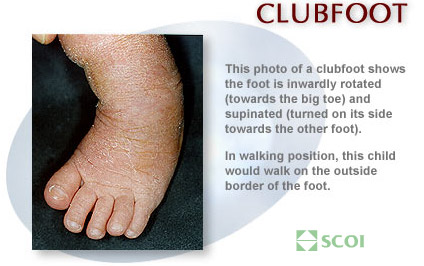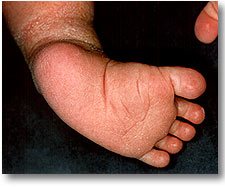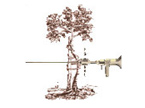
Birth deformities of the foot fall into two categories: positional deformities, and malformations.
Positional deformities are “packaging defects” of the foot. Malformations are “manufacturing defects” in which the parts are incorrectly formed. A true clubfoot is a malformation. The bones, joints, muscles, and blood vessels of the limb are abnormal. The medical term for this is “talipes equinovarus” — relating the shape of the foot to a horses hoof. Don’t ask why!
Clubfoot can be recognized in the infant by examination. The foot is inturned, stiff and cannot be brought to a normal position. Children with the condition should be referred to an orthopedic surgeon for complete evaluation and treatment of the deformity.
Clubfoot can be recognized in the infant by examination. The foot is inturned, stiff and cannot be brought to a normal position. Children with the condition should be referred to an orthopedic surgeon for complete evaluation and treatment of the deformity.
This rear view of the clubfoot shows the heel retracted towards the leg (equinus). Note the medial (inner) crease and curved lateral (outer) border of the foot. This foot cannot be brought to plantigrade position, meaning flat on the floor.

The usual treatment of clubfoot is a series of corrective casts applied early in life to stretch the foot into as corrected a position as possible. Frequently surgery is also needed to release the stiff and misaligned joints of the foot to make it “plantigrade” or flat to the floor. The result of such treatment is usually good with a adequate foot for normal footwear, sports, and cosmesis. Sometimes later in life or late childhood, there can be pain in the foot necessitating special shoe modifications such as arch supports, or even additional corrective surgery.
A true clubfoot is usually stiff and will lack normal motion, be smaller than a normal foot, and the muscularity of the calf will be noticeably smaller. Sports, exercise, and corrective surgery can be used to strengthen and realign the foot, but there is always a distinct difference between the normal side and the clubfoot.
The treatment of clubfoot is rather involved, and best managed by Orthopedic surgeons experienced in the techniques mentioned above.
Text & photos by Steven A. Schopler, MD
Southern California Orthopedic Institute


